Valuating Hydrological Ecosystem Services Provided by Groundwater in a Dryland Region in the Northwest of Mexico
Abstract
1. Introduction
1.1. Study Area
1.1.1. Hydrogeological Conditions
1.1.2. Water Use
2. Materials and Methods
2.1. Valuation Methods for Provisioning HESs
2.1.1. Groundwater for Agricultural Use
2.1.2. Groundwater for Industrial Use
2.1.3. Groundwater for Urban and Domestic Use
2.2. Valuation Methods for Regulating HESs
2.2.1. Water Conservation
2.2.2. Water Purification
2.3. Valuation Methods for Cultural HESs
Recreation
3. Results and Discussion
3.1. Provisioning Hydrological Ecosystem Services
3.1.1. Groundwater for Agricultural Use
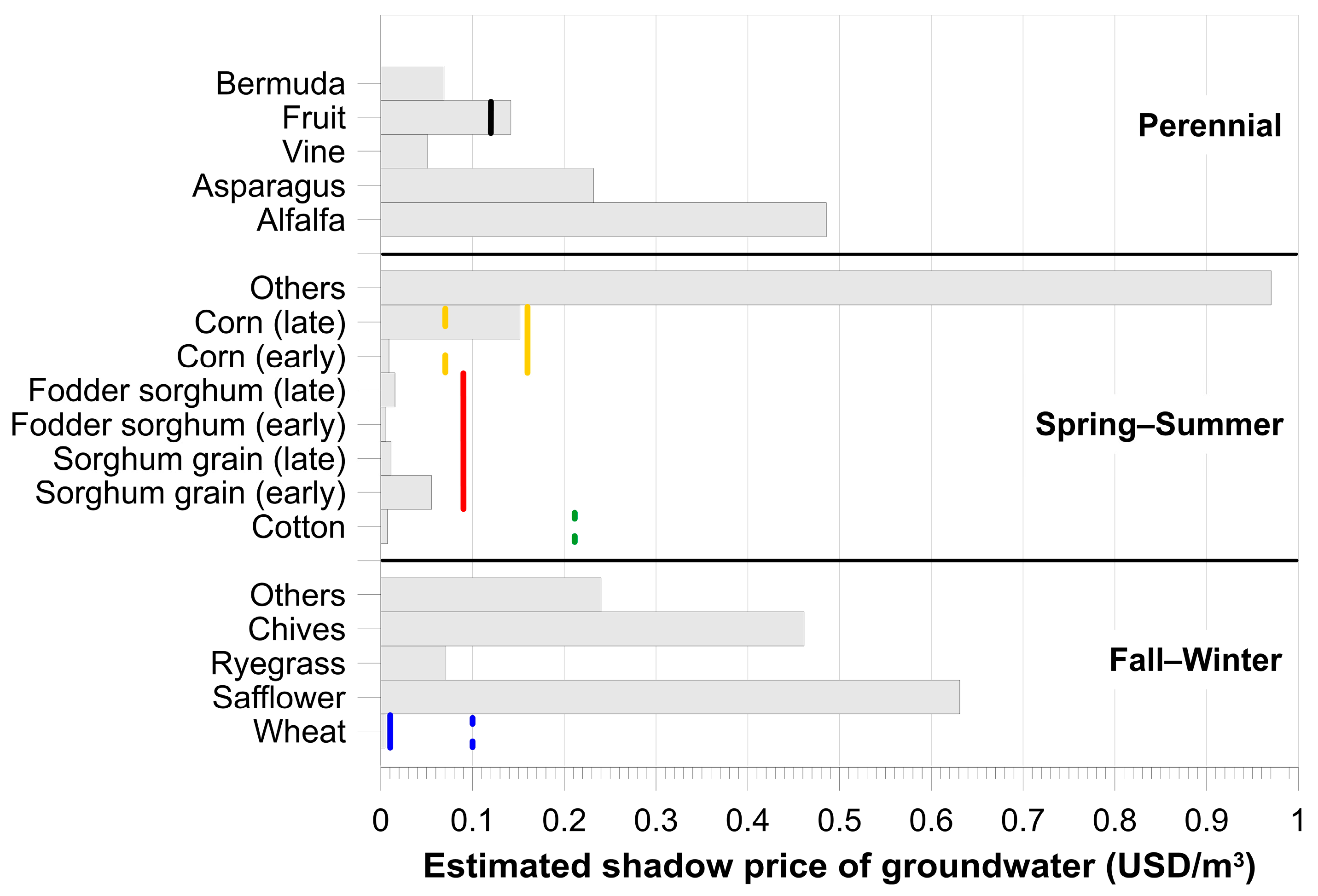
3.1.2. Groundwater for Industrial Use
3.1.3. Groundwater for Urban and Domestic Use
3.2. Regulating Ecosystem Services
3.2.1. Water Conservation
3.2.2. Water Purification
3.3. Cultural Ecosystem Services
Recreation
4. Conclusions
Author Contributions
Funding
Data Availability Statement
Acknowledgments
Conflicts of Interest
Abbreviations
| HESs | hydrological ecosystem services |
| ESs | ecosystem services |
| CR | Colorado River |
| CRD | Colorado River Delta |
| DR014 | Colorado River 014 Irrigation District |
| SW | surface water |
| GW | groundwater |
| NGOs | non-governmental organizations |
| MVA | Mexicali Valley aquifer |
| SLRCA | San Luis Río Colorado aquifer |
| CESPM | State Water Commission of Public Services of Mexicali |
| OOMAPAS | San Luis Río Colorado Drinking Water, Sewerage, and Sanitation Operator Agency |
| REPDA | Public Registry of Water Rights |
References
- Burrell, A.L.; Evans, J.P.; De Kauwe, M.G. Anthropogenic climate change has driven over 5 million km2 of drylands towards desertification. Nat. Commun. 2020, 11, 3853. [Google Scholar] [CrossRef] [PubMed]
- Millennium Ecosystem Assessment. Ecosystems and Human Well-Being: Synthesis; Island Press: Washington, DC, USA, 2005. [Google Scholar]
- Huang, F.; Zhang, Y.; Zhang, D.; Chen, X. Environmental Groundwater Depth for Groundwater-Dependent Terrestrial Ecosystems in Arid/Semiarid Regions: A Review. Int. J. Environ. Res. Public Health 2019, 16, 763. [Google Scholar] [CrossRef] [PubMed]
- Chapin, F.S.; Matson, P.A.; Vitousek, P.M. The Ecosystem Concept. In Principles of Terrestrial Ecosystem Ecology; Springer: New York, NY, USA, 2011; pp. 3–22. [Google Scholar]
- Young, R.A.; Loomis, J.B. Determining the Economic Value of Water: Concepts and Methods; Routledge: New York, NY, USA, 2014. [Google Scholar]
- Postel, S.; Carpenter, S. Freshwater ecosystem services. In Nature’s Services: Societal Dependence on Natural Ecosystems; Island Press: Washington, DC, USA, 1997; Volume 195. [Google Scholar]
- Brauman, K.A.; Daily, G.C.; Duarte, T.K.E.; Mooney, H.A. The Nature and Value of Ecosystem Services: An Overview Highlighting Hydrologic Services. Annu. Rev. Environ. Resour. 2007, 32, 67–98. [Google Scholar] [CrossRef]
- Bergkamp, G.; Cross, K. Groundwater and ecosystem services: Towards their sustainable use. In Proceedings of the International Symposium on Groundwater Sustainability, Alicante, Spain, 24–27 January 2006; InterAcademy Panel: Trieste, Italy, 2006; pp. 177–193. [Google Scholar]
- Hérivaux, C.; Grémont, M. Valuing a diversity of ecosystem services: The way forward to protect strategic groundwater resources for the future? Ecosyst. Serv. 2019, 35, 184–193. [Google Scholar] [CrossRef]
- Herman, J.S.; Culver, D.C.; Salzman, J. Groundwater ecosystems and the service of water purification. Stan. Envtl. LJ 2001, 20, 479. [Google Scholar]
- CGIAR Research Program on Water, Land and Ecosystems (WLE). Groundwater and Ecosystem Services: A framework for Managing Smallholder Groundwater-Dependent Agrarian Socio-Ecologies—Applying an Ecosystem Services and Resilience Approach; International Water Management Institute (IWMI): Colombo, Sri Lanka, 2015; p. 25. [Google Scholar] [CrossRef]
- Griebler, C.; Avramov, M. Groundwater ecosystem services: A review. Freshw. Sci. 2015, 34, 355–367. [Google Scholar] [CrossRef]
- Griebler, C.; Avramov, M.; Hose, G. Groundwater Ecosystems and Their Services: Current Status and Potential Risks. In Atlas of Ecosystem Services: Drivers, Risks, and Societal Responses; Schröter, M., Bonn, A., Klotz, S., Seppelt, R., Baessler, C., Eds.; Springer International Publishing: Cham, Switzerland, 2019; pp. 197–203. [Google Scholar]
- Yang, X.; Liu, J. Assessment and Valuation of Groundwater Ecosystem Services: A Case Study of Handan City, China. Water 2020, 12, 1455. [Google Scholar] [CrossRef]
- Favretto, N.; Stringer, L.C.; Dougill, A.J.; Dallimer, M.; Perkins, J.S.; Reed, M.S.; Atlhopheng, J.R.; Mulale, K. Multi-Criteria Decision Analysis to identify dryland ecosystem service trade-offs under different rangeland land uses. Ecosyst. Serv. 2016, 17, 142–151. [Google Scholar] [CrossRef]
- Dodds, W.K.; Perkin, J.S.; Gerken, J.E. Human Impact on Freshwater Ecosystem Services: A Global Perspective. Environ. Sci. Technol. 2013, 47, 9061–9068. [Google Scholar] [CrossRef] [PubMed]
- Lin, J.; Huang, J.; Prell, C.; Bryan, B.A. Changes in supply and demand mediate the effects of land-use change on freshwater ecosystem services flows. Sci. Total Environ. 2021, 763, 143012. [Google Scholar] [CrossRef] [PubMed]
- ICWE (International Conference on Water and the Environment). The Dublin Statement on Water and Sustainable Development. In Proceedings of the International Conference on Water and the Environment, Dublin, Ireland, 26–31 January 1992; p. 70. [Google Scholar]
- Briscoe, J. Water as an economic good: The idea and what it means in practice. In Proceedings of the 16th International Congress on Irrigation and Drainage, Cairo, Egypt, 15–22 September 1996. [Google Scholar]
- UNESCO. The United Nations World Water Development Report 2021 Valuing Water; UNESCO: Paris, France, 2021; p. 206. [Google Scholar]
- Rogers, P.; Silva, R.d.; Bhatia, R. Water is an economic good: How to use prices to promote equity, efficiency, and sustainability. Water Policy 2002, 4, 1–17. [Google Scholar] [CrossRef]
- Garrick, D.E.; Hall, J.W.; Dobson, A.; Damania, R.; Grafton, R.Q.; Hope, R.; Hepburn, C.; Bark, R.; Boltz, F.; De Stefano, L.; et al. Valuing water for sustainable development. Science 2017, 358, 1003–1005. [Google Scholar] [CrossRef] [PubMed]
- de Groot, R.; Brander, L.; van der Ploeg, S.; Costanza, R.; Bernard, F.; Braat, L.; Christie, M.; Crossman, N.; Ghermandi, A.; Hein, L.; et al. Global estimates of the value of ecosystems and their services in monetary units. Ecosyst. Serv. 2012, 1, 50–61. [Google Scholar] [CrossRef]
- Aylward, B.; Seely, H.; Hartwell, R.; Dengel, J. The Economic Value of Water for Agricultural, Domestic and Industrial Uses: A Global Compilation of Economic Studies and Market Prices; UN FAO: Bend, OR, USA, 2010; p. 46. [Google Scholar]
- Emerton, L.; Bos, E. Value. Counting Ecosystems as an Economic Part of Water; IUCN: Gland, Switzerland; Cambridge, UK, 2004; p. 88. [Google Scholar]
- Turner, R.K. Economic Valuation of Water Resources in Agriculture: From the Sectoral to a Functional Perspective of Natural Resource Management; Food & Agriculture organization: Rome, Italy, 2004; Volume 27. [Google Scholar]
- Dolan, F.; Lamontagne, J.; Link, R.; Hejazi, M.; Reed, P.; Edmonds, J. Evaluating the economic impact of water scarcity in a changing world. Nat. Commun. 2021, 12, 1915. [Google Scholar] [CrossRef] [PubMed]
- USBR (US Deparment of the Interior, Bureau of Reclamation). Colorado River Basin Water Supply and Demand Study Executive Summary; U.S. Deparment of the Interior, Bureau of Reclamation: Washington, DC, USA, 2012; p. 34.
- Best, A. Hydraulic Empire Sharing a Legacy, Carving a Future for the Colorado River. Land Lines, 14 December 2018; 6. [Google Scholar]
- DeLuca, W.V.; Meehan, T.; Seavy, N.; Jones, A.; Pitt, J.; Deppe, J.L.; Wilsey, C.B. The Colorado River Delta and California’s Central Valley are critical regions for many migrating North American landbirds. Condor Ornithol. Appl. 2021, 123, duaa064. [Google Scholar] [CrossRef]
- Rivera-Torres, M.; Gerlak, A.K. Evolving together: Transboundary water governance in the Colorado River Basin. Int. Environ. Agreem. Politics Law Econ. 2021, 21, 553–574. [Google Scholar] [CrossRef] [PubMed]
- López-Hoffman, L.; Varady, R.G.; Flessa, K.W.; Balvanera, P. Ecosystem services across borders: A framework for transboundary conservation policy. Front. Ecol. Environ. 2010, 8, 84–91. [Google Scholar] [CrossRef]
- Kaval, P. Ecosystem Service Valuation of the Colorado River Basin: A Literature Review and Assessment of the Total Economic Value of the Colorado River Basin; The Nature Conservancy: Washington, DC, USA, 2011. [Google Scholar]
- Flessa, K.W. Ecosystem services and the value of water in the Colorado River delta and Estuary, USA and Mexico: Guidelines for mitigation and restoration. In Proceedings of the International Seminar on Restoration of Damaged Lagoon Environments, Matsue, Japan, 10–11 January 2004. [Google Scholar]
- Sanjurjo, R.E.; Islas, C.I. Valoración económica de la actividad recreativa en el río Colorado. Región Y Soc. 2007, 9, 26. [Google Scholar] [CrossRef]
- Bark, R.H.; Robinson, C.J.; Flessa, K.W. Tracking cultural ecosystem services: Water chasing the Colorado River restoration pulse flow. Ecol. Econ. 2016, 127, 165–172. [Google Scholar] [CrossRef]
- Kerna, A.; Colby, B.; Zamora, F. Cultural and Recreational Values for Environmental Flows in Mexico’s Colorado River Delta. Water Econ. Policy 2017, 03, 1650035. [Google Scholar] [CrossRef]
- Lomelí, M.A. Ecohidrología de la Ciénega de Santa Clara: Adaptación al Cambio Climático y su Valor Ecosistémico. Ph.D. Thesis, Universidad Autónoma de Baja California, Mexicali, Mexico, 2016. [Google Scholar]
- Cital, F.; Ramírez-Hernández, J.; García-Hernández, J.; García-Leyva, G.; Rodríguez-Burgueño, J.E.; Ramírez-Barreto, M.E. Ecosystem services (ES) provided by ditches in a desert agricultural valley. Ecol. Eng. 2022, 174, 106462. [Google Scholar] [CrossRef]
- Famiglietti, J.S. The global groundwater crisis. Nat. Clim. Chang. 2014, 4, 945–948. [Google Scholar] [CrossRef]
- Ramírez-Hernández, J. Las aguas subterráneas transfronterizas del delta del río Colorado, un reto para la cooperación. In Visiones Contemporáneas de la Cooperación y la Gestión Del Agua en la Frontera México-Estados Unidos; Castro Ruiz, J.L., Cortez Lara, A., Sánchez Munguía, V., Eds.; El Colegio de la Frontera Norte: Tijuana, Mexico, 2021; pp. 177–211. [Google Scholar]
- CDWR. References Evapotranspiration Zones; California Department of Water Resources: Sacramento, CA, USA, 2012; p. 4. [Google Scholar]
- INEGI. Censo de Población y Vivienda 2020; Geografía, I.N.D.E.Y., Ed.; INEGI: Aguascalientes, Mexico, 2020. [Google Scholar]
- Ramírez-Hernández, J.; Hinojosa-Huerta, O.; Peregrina-Llanes, M.; Calvo-Fonseca, A.; Carrera-Villa, E. Groundwater responses to controlled water releases in the limitrophe region of the Colorado River: Implications for management and restoration. Ecol. Eng. 2013, 59, 93–103. [Google Scholar] [CrossRef]
- Elders, W.A.; Rex, R.W.; Robinson, P.T.; Biehler, S.; Meidav, T. Crustal Spreading in Southern California. Science 1972, 178, 15–24. [Google Scholar] [CrossRef] [PubMed]
- Ariel. Estudio Hidrogeológico Completo de Los Acuíferos del Valle de Mexicali, B.C. y Mesa de San Luis, Son; Comisión Nacional del Agua: Mexico City, Mexico, 1968; p. 138. [Google Scholar]
- Siem, M.E. The Structure and Petrology of Sierra El Mayor, Northeastern Baja California, Mexico. Master’s Thesis, San Diego State University, San Diego, CA, USA, 1992. [Google Scholar]
- Pacheco, M.; Martín-Barajas, A.; Elders, W.; Espinosa-Cardeña, J.M.; Helenes, J.; Segura, A. Stratigraphy and structure of the Altar basin of NW Sonora: Implications for the history of the Colorado River delta and the Salton trough. Rev. Mex. Cienc. Geológicas 2018, 23, 1–22. [Google Scholar]
- Makdisi, R.; Truesdell, A.; Thompson, J.; Coplen, T.; Sanchez, J. Chemical evolution of Mexicali Valley groundwater. In Proceedings of the 4th Symposium on the Cerro Prieto Geothermal Field, Guadalajara, Jalisco, Mexico, 10–12 August 1982. [Google Scholar]
- Payne, B.R.; Quijano, L.; Carlos Latorre, D. Environmental isotopes in a study of the origin of salinity of groundwater in the Mexicali Valley. J. Hydrol. 1979, 41, 201–215. [Google Scholar] [CrossRef]
- REPDA. Registro Público de Derechos de Agua. Acuíferos Valle de Mexicali y Valle de San Luis Río Colorado, Sonora; Agua, C.N.D., Ed.; Registro Público de Derechos de Agua: Mexico City, Mexico, 2021. [Google Scholar]
- CONAGUA. Estadísticas Agrícolas de Los Distritos de Riego, Año Agrícola 2017–2018; Agua, C.N.D., Ed.; CONAGUA: Mexico City, Mexico, 2019. [Google Scholar]
- SEDAGRO. Programa de Georreferenciación de Cultivos. Informe de Resultados del Recorrido de Campo del Valle de Mexicali, 2018; Secretaría de Desarrollo Agropecuario: Mexicali, Mexico, 2018. [Google Scholar]
- Baxter, W.T. Depreciation; Sweet & Maxwell: London, England, 1971; p. 182. [Google Scholar]
- Bierkens, M.F.P.; Reinhard, S.; de Bruijn, J.A.; Veninga, W.; Wada, Y. The Shadow Price of Irrigation Water in Major Groundwater-Depleting Countries. Water Resour. Res. 2019, 55, 4266–4287. [Google Scholar] [CrossRef]
- Guzmán, R.S.; Valenzuela, S.P.; Féliz, V.P.; Jimenéz, T.A.; Ruiz, C.S. Necesidades Hídricas de Los Principales Cultivos en Baja California; INIFAP, Ed.; INIFAP: Mexicali, Mexico, 2009. [Google Scholar]
- Espey, M.; Espey, J.; Shaw, W.D. Price elasticity of residential demand for water: A meta-analysis. Water Resour. Res. 1997, 33, 1369–1374. [Google Scholar] [CrossRef]
- Garrone, P.; Grilli, L.; Marzano, R. Price elasticity of water demand considering scarcity and attitudes. Util. Policy 2019, 59, 100927. [Google Scholar] [CrossRef]
- Pearce, D.W.; Pretty, J.N. Economic Values and the Natural World; Earthscan: London, UK, 1993. [Google Scholar]
- Rodríguez-Burgueño, J.E. Modelación Geohidrológica Transitoria de la Relación Acuífero-Río de la Zona FFCC-Vado Carranza Del Río Colorado Con Propósito de Manejo de la Zona Riparia. Master’s Thesis, Universidad Autónoma de Baja California, Mexicali, Mexico, 2012. [Google Scholar]
- CESPM. Indicadores Sistema de la Ciudad de Mexicali. Comparativo General; Comisión Estatal de Servicios Públicos de Mexicali: Mexicali, Mexico, 2021. [Google Scholar]
- Pitt, J.; Kendy, E. Shaping the 2014 Colorado River Delta pulse flow: Rapid environmental flow design for ecological outcomes and scientific learning. Ecol. Eng. 2017, 106, 704–714. [Google Scholar] [CrossRef]
- D’Odorico, P.; Chiarelli, D.D.; Rosa, L.; Bini, A.; Zilberman, D.; Rulli, M.C. The global value of water in agriculture. Proc. Natl. Acad. Sci. USA 2020, 117, 21985–21993. [Google Scholar] [CrossRef] [PubMed]
- Williams, R.B.; Al-Hmoud, R.; Segarra, E.; Mitchell, D. An estimate of the shadow price of water in the southern Ogallala Aquifer. J. Water Resour. Prot. 2017, 9, 289–304. [Google Scholar] [CrossRef]
- Frederick, D.K.; VandenBerg, T.; Hanson, J. Economic Values of Freshwater in the United States; Resources for the Future; AgEcon Search: Washington, DC, USA, 1996; p. 36. [Google Scholar]
- CONAGUA. Estudio de Determinación de la Demanda en Ensenada, Mexicali y Tijuana; Comisión Nacional del Agua: Mexico City, Mexico, 1999. [Google Scholar]
- Revollo-Fernández, D.A.; Rodríguez-Tapia, L.; Morales-Novelo, J.A. Economic value of water in the manufacturing industry located in the Valley of Mexico Basin, Mexico. Water Resour. Econ. 2020, 30, 100138. [Google Scholar] [CrossRef]
- Dachraoui, K.; Harchaoui, M.T. Water Use, Shadow Prices and the Canadian Business Sector Productivity Performance; Statistics Canada, Micro-Economic Analysis Division, Eds.; Statistics Canada: Ottawa, ON, Canada, 2004; p. 28. [Google Scholar]
- Kumar, S.; Managi, S. Industrial Water Demand and Shadow Price. In The Economics of Sustainable Development: The Case of India; Managi, S., Kumar, S., Eds.; Springer: New York, NY, USA, 2009; pp. 167–181. [Google Scholar]
- Schild, J.E.M.; Vermaat, J.E.; de Groot, R.S.; Quatrini, S.; van Bodegom, P.M. A global meta-analysis on the monetary valuation of dryland ecosystem services: The role of socio-economic, environmental and methodological indicators. Ecosyst. Serv. 2018, 32, 78–89. [Google Scholar] [CrossRef]




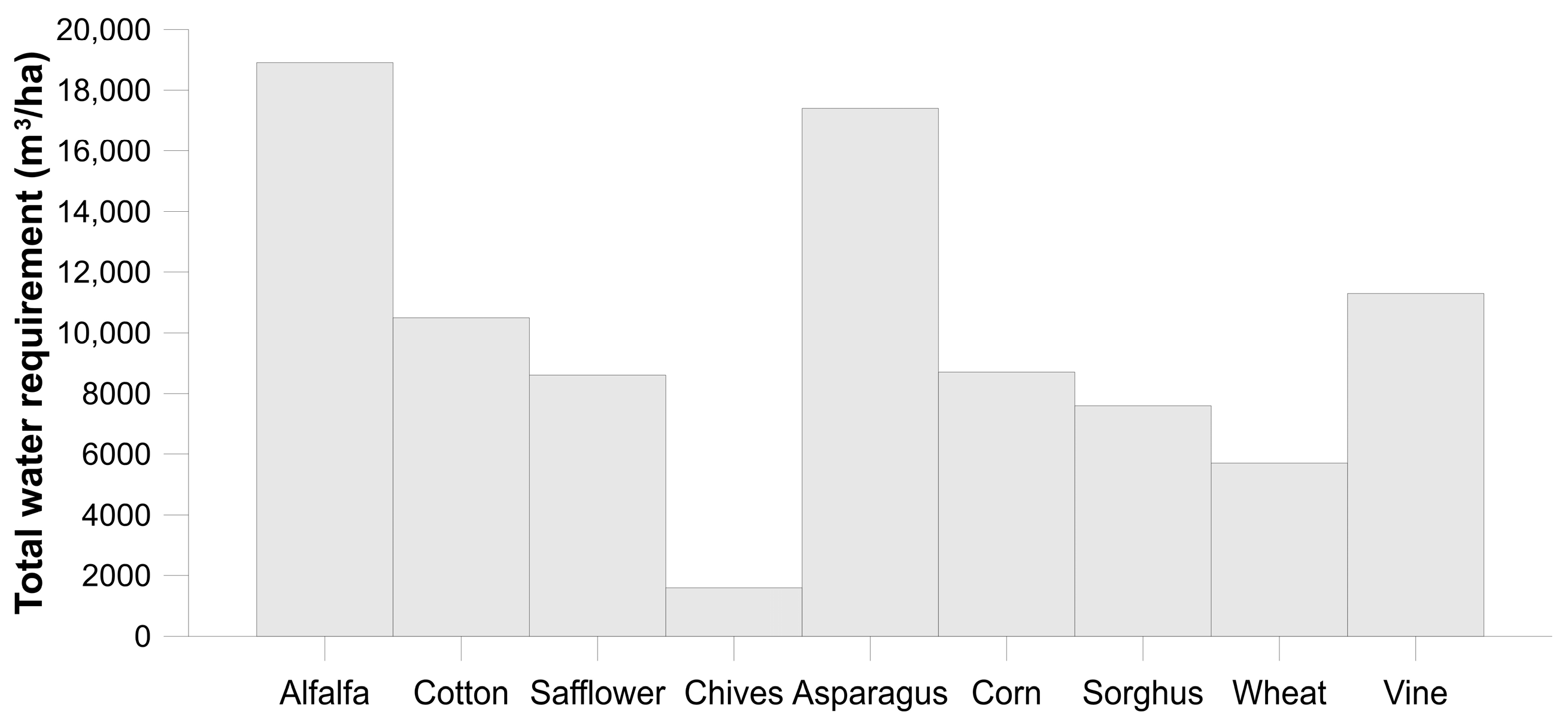
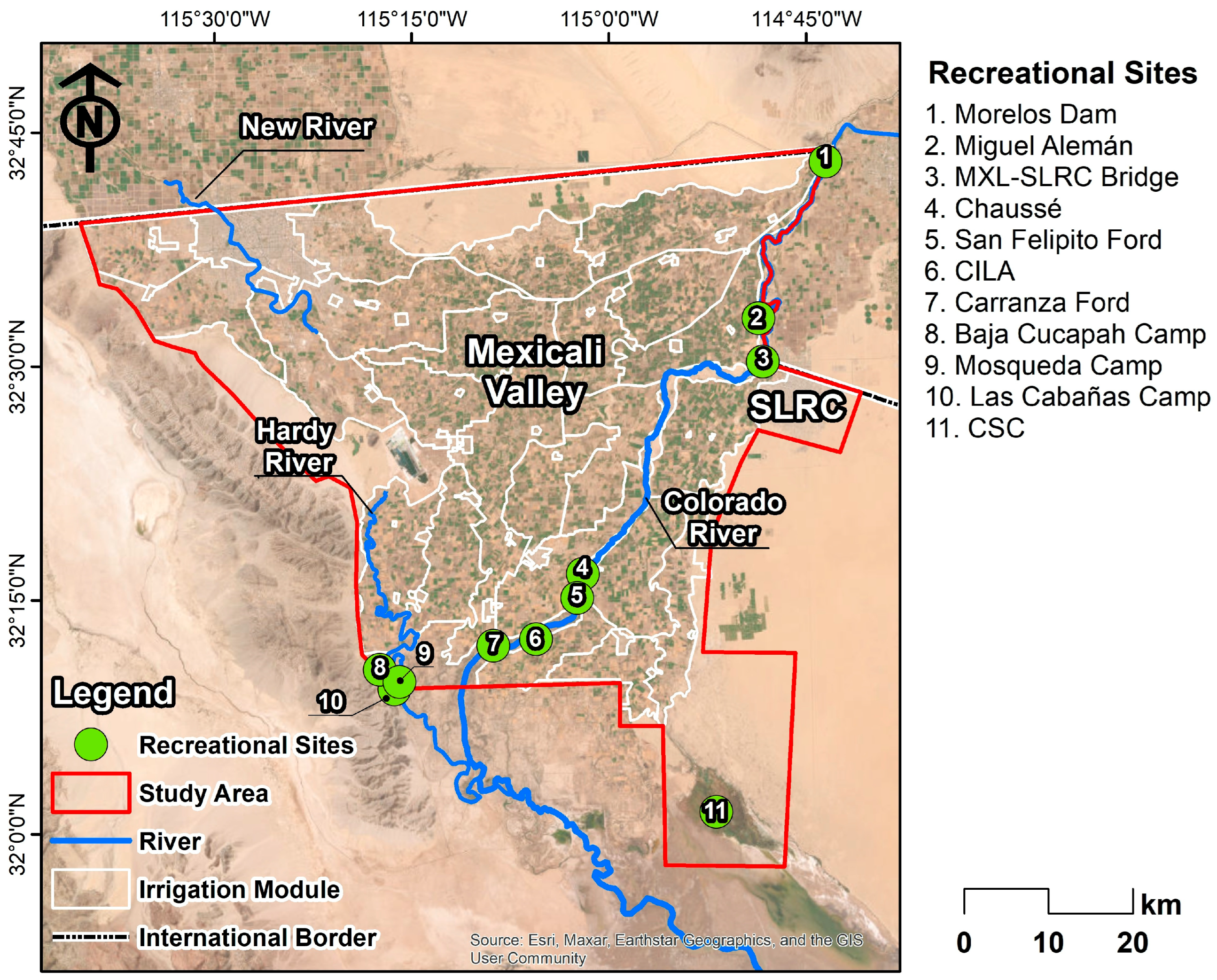
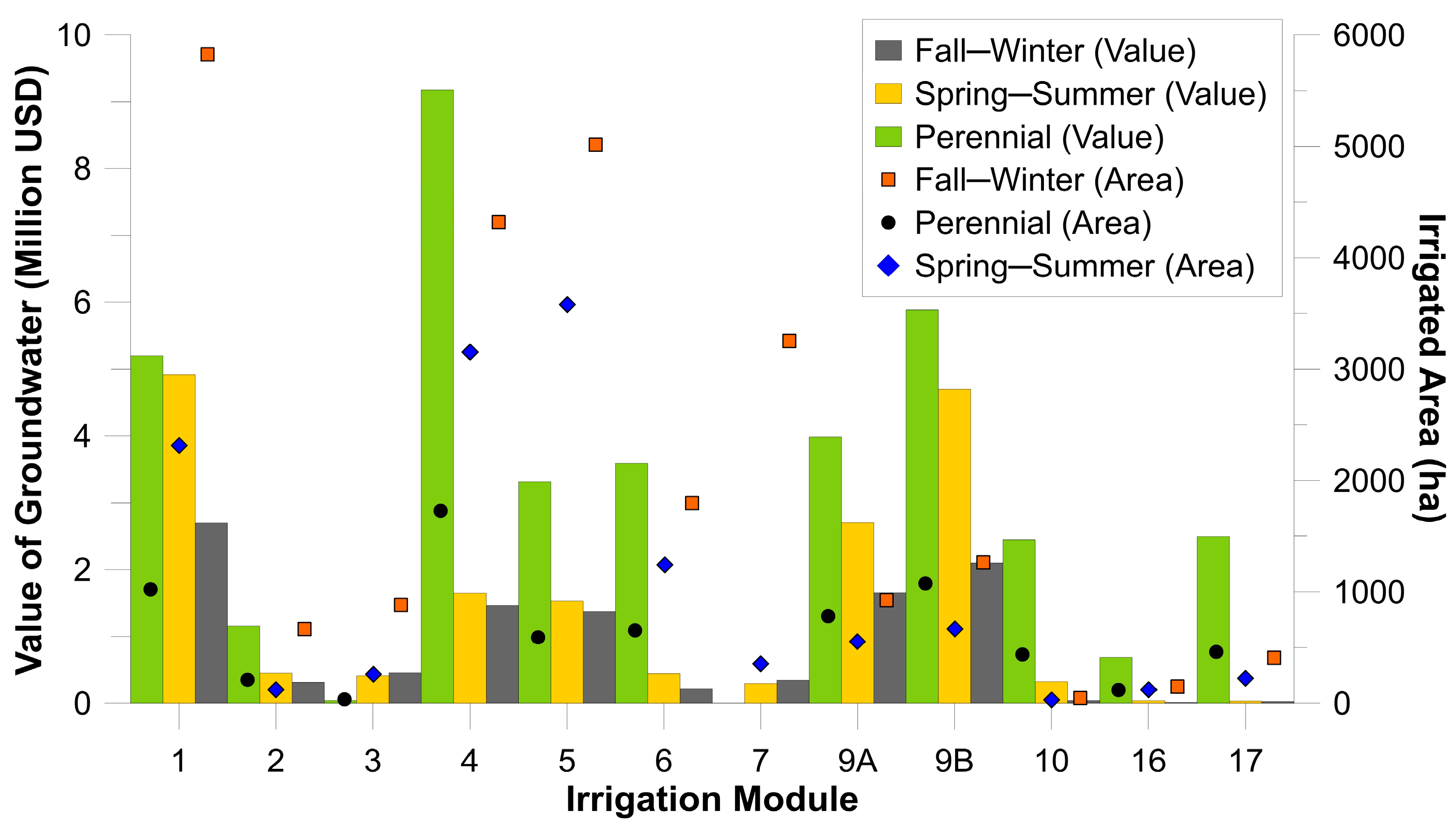
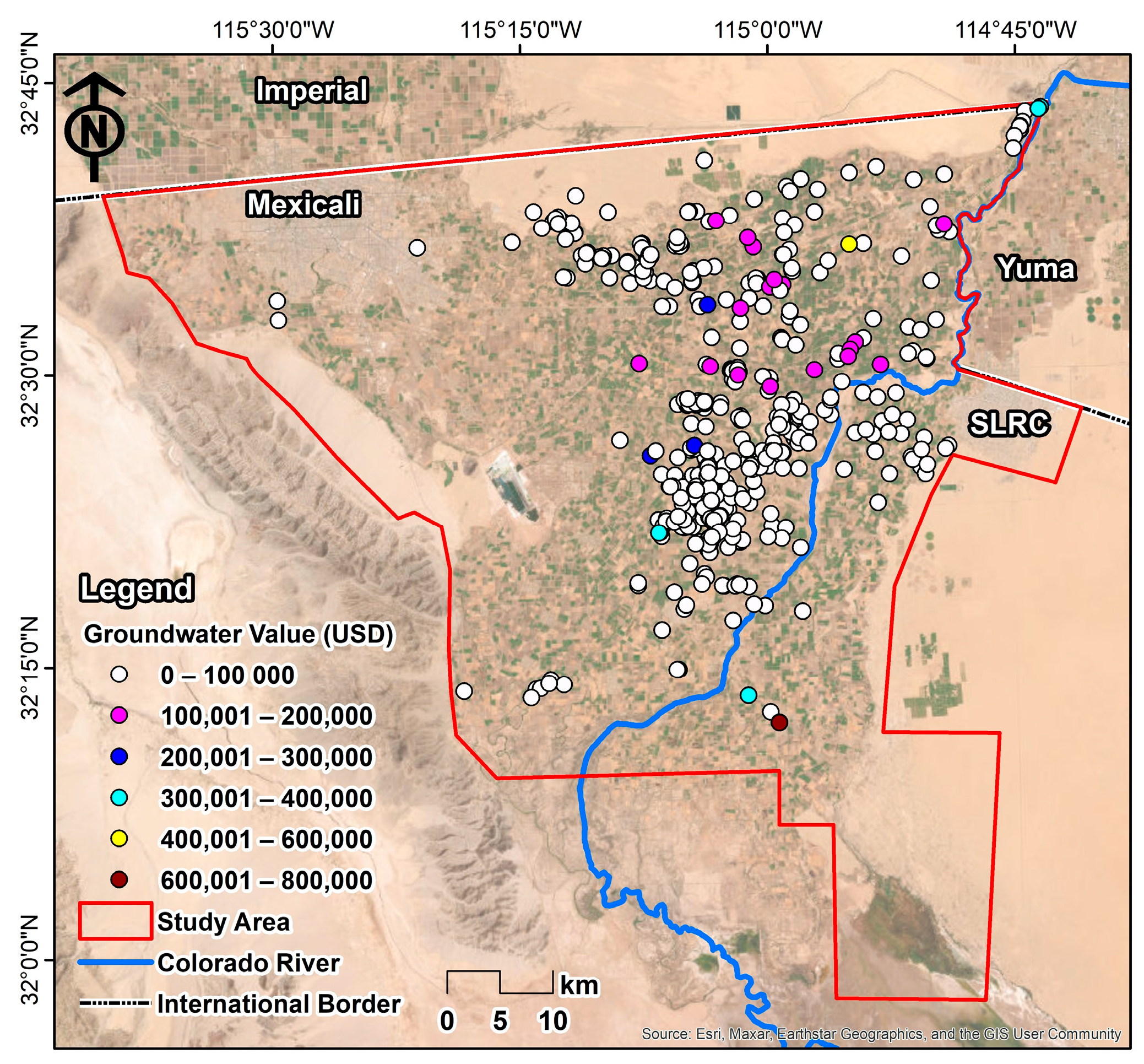
| Valuation Method | Description | Direct Use Values | Indirect Use Values | Non-Use Values | Good or ES |
|---|---|---|---|---|---|
| Market analysis and market-based transactions | Used where market prices of outputs and inputs are available. Marginal productivity net of human effort/cost. Could also be approximated using the market price of a close substitute. Includes transactions in water rights. May require shadow prices *. | x | x | Provision of water; erosion, flood, and storm protection; improve water and air quality; recreation; scientific purposes; regulation of climate | |
| Residual imputation and variants | Budget analysis used to estimate return attributable to water. Water is treated as one in the production of a good. The total returns are calculated; all non-water expenses are subtracted. Change in net return from marketed goods: a form of (dose-response) market analysis. | x | x | Provision of water; erosion, flood, and storm protection; improve water and air quality; recreation; scientific purposes; regulation of climate | |
| Hedonic price method | Derive an implicit price for an environmental good from analysis of goods for which market exists that incorporate environmental characteristics. | x | x | Provision of water; erosion, flood, and storm protection; improve water and air quality; scientific purposes | |
| Travel cost method | Costs incurred in reaching a recreation site as a proxy for the value of recreation. Expenses differ between sites (or for the same site over time) with different environmental attributes. | x | x | x | Recreation; scientific purposes |
| Contingent valuation method (CVM) | Construction of a hypothetical market by direct surveying of a sample of individuals and aggregation to encompass the relevant population. Problems of potential biases. | x | x | x | Provision of water; erosion, flood, and storm protection; improve water and air quality; recreation; scientific purposes; regulation of climate |
| Replacement/costs savings | Potential expenditures incurred in replacing or restoring the function that is lost; for instance, using substitute facilities or “shadows projects”. A total value approach; important ecological, temporal, and cultural dimensions. | x | x | x | Provision of water; erosion, flood, and storm protection; improve water and air quality; recreation; scientific purposes; regulation of climate |
| Service Types | Service Indicators |
|---|---|
| Provisioning | Water supply (domestic, industrial, agricultural, and power generation activities) |
| Regulating | Water conservation Air regulation Water purification |
| Cultural | Recreation |
| WWTP | Capacity (L/s) | Discharge Effluent |
|---|---|---|
| Mexicali I | 1300 | International drain (New River) |
| Las Arenitas | 840 | Hardy River |
| Los Algodones | 20 | Agricultural drain |
| Cd. Morelos | 30 | Álamo Canal |
| Km. 43 | 70 | Agricultural drain |
| Km. 57 | 20 | Agricultural drain |
| Season | Cultivated Surface (ha) | Total Market Value (USD Million) | Value Per Surface Area (USD/ha) |
|---|---|---|---|
| Fall–Winter | 24,557 | 11 | 435 |
| Spring–Summer | 12,610 | 17 | 1386 |
| Perennial | 7099 | 38 | 5349 |
| Total | 44,266 | 66 | 1494 |
| WWTP | Value of Water Purification (USD/yr) |
|---|---|
| Mexicali I | 45,096 |
| Las Arenitas | 37,086 |
| Los Algodones | 4131 |
| Cd. Morelos | 6197 |
| Km. 43 | 14,459 |
| Km. 57 | 4131 |
| Type of ES | HES Groundwater Uses | Total Annual Value (USD Million) |
|---|---|---|
| Provisioning | Agriculture | 66 |
| Industry | 0.42 | |
| Urban and domestic | 11.07 | |
| Regulating | Conservation | 883,440 |
| Water purification | 0.11 | |
| Cultural | Recreation | 2.99 |
| Total | 883,520.59 | |
Disclaimer/Publisher’s Note: The statements, opinions and data contained in all publications are solely those of the individual author(s) and contributor(s) and not of MDPI and/or the editor(s). MDPI and/or the editor(s) disclaim responsibility for any injury to people or property resulting from any ideas, methods, instructions or products referred to in the content. |
© 2025 by the authors. Licensee MDPI, Basel, Switzerland. This article is an open access article distributed under the terms and conditions of the Creative Commons Attribution (CC BY) license (https://creativecommons.org/licenses/by/4.0/).
Share and Cite
Cital, F.; Rodríguez-Burgueño, J.E.; Carreón-Diazconti, C.; Ramírez-Hernández, J. Valuating Hydrological Ecosystem Services Provided by Groundwater in a Dryland Region in the Northwest of Mexico. Water 2025, 17, 2221. https://doi.org/10.3390/w17152221
Cital F, Rodríguez-Burgueño JE, Carreón-Diazconti C, Ramírez-Hernández J. Valuating Hydrological Ecosystem Services Provided by Groundwater in a Dryland Region in the Northwest of Mexico. Water. 2025; 17(15):2221. https://doi.org/10.3390/w17152221
Chicago/Turabian StyleCital, Frida, J. Eliana Rodríguez-Burgueño, Concepción Carreón-Diazconti, and Jorge Ramírez-Hernández. 2025. "Valuating Hydrological Ecosystem Services Provided by Groundwater in a Dryland Region in the Northwest of Mexico" Water 17, no. 15: 2221. https://doi.org/10.3390/w17152221
APA StyleCital, F., Rodríguez-Burgueño, J. E., Carreón-Diazconti, C., & Ramírez-Hernández, J. (2025). Valuating Hydrological Ecosystem Services Provided by Groundwater in a Dryland Region in the Northwest of Mexico. Water, 17(15), 2221. https://doi.org/10.3390/w17152221







